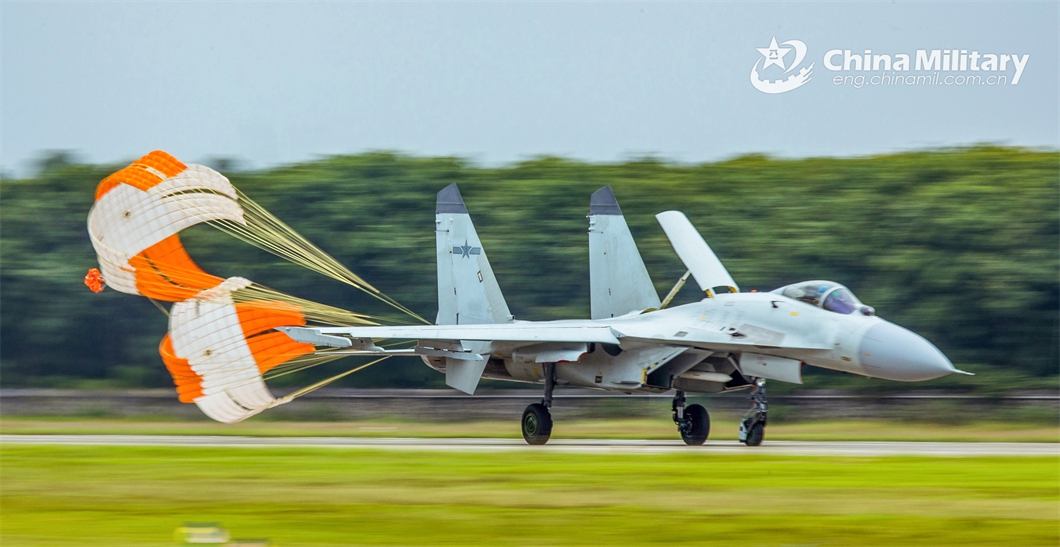
A fighter jet attached to a naval aviation unit under the PLA Southern Theater Command pops a drag parachute to slow down on the runway after completing a multi-subject flight training exercise on June 13, 2024. (Photo: chinamil.com.cn)
The South China Sea is the world's most open sea, with tens of thousands of ship-days of surface force presence, sorties of military aircraft, hundreds of large-scale exercises, and thousands of smaller drills conducted annually by countries both within and outside the region. The Chinese military does not engage in confrontational encounters except in a few exceptional scenarios, including foreign military forces entering Chinese territorial waters and airspace, according to a latest think tank report.
The real threats to maritime freedom in the South China Sea come from the so-called freedom of navigation operations conducted by the US military, close-in reconnaissance operations, and intrusions into other countries' military exercise zones, while the disputes over islands and reefs in the South China Sea have little impact on navigation and overflight, the report said.
Beijing-based think tank South China Sea Strategic Situation Probing Initiative (SCSPI) released the report on the navigation and overflight situation in the South China Sea on Friday.
Countries both within and outside the region maintain a presence of over 20,000 ship-days and around 30,000 sorties of military aircraft in the South China Sea each year, along with hundreds of large-scale drills and thousands of various exercises, according to data released by the SCSPI.
Military activities by coastal countries are increasing, and extra-regional countries, particularly the US military, are conducting significant operations in the South China Sea. Every year, the US Navy maintains approximately 1,600 ship-days of surface vessel presence and an undisclosed number of submarines (combat vessels) in the South China Sea, as well as over 3,000 ship-days of auxiliary vessel activities. Overall, US Air Force, Navy, Marine Corps and Army conduct approximately 8,000 sorties of aircraft annually in the region, including reconnaissance aircraft, transport aircraft, refueling aircraft, fighter jets and bombers, the report said.
Air and maritime encounters between military forces, particularly between China and the US, occur frequently in the South China Sea. Over 10 China-US encounters occur daily and thousands annually, the SCSPI said, noting that the majority of these encounters are professional and safe.
For foreign military vessels and aircraft entering China's jurisdictional waters and surrounding airspace, the report said that the Chinese military follows and monitors the situation based on international practice for safety and security reasons. Frictions primarily arise only when foreign forces approach the Chinese mainland or Hainan Island territorial waters and airspace, when the US military enters the territorial waters and airspace of Xisha Qundao for so-called freedom of navigation operations, when foreign forces enter within 12 nautical miles of Chinese-controlled features in the Nansha Qundao and Huangyan Dao, and when foreign forces excessively approach or intrude into Chinese military exercises.
Some foreign militaries often complain about being intercepted by Chinese forces, portraying the South China Sea as restricted and unsafe. However, they conveniently avoid discussing essential information such as the specific locations of encounters and the reasons behind such incidents, clearly indicating a biased narrative, Hu Bo, director of SCSPI, told the Global Times.
Any country facing challenges similar to the scenarios above-mentioned would take decisive measures, with countries like the US responding even more assertively, Hu said.
The true threats to maritime freedom in the South China Sea stem from extra-regional military operations, including the US military's so-called freedom of navigation operations, provocations that approach or intrude into the coastal state's territorial waters and airspace, and intrusions into temporary military exercise areas of other countries, according to the SCSPI report.
The report also provided analysis on the impact of the South China Sea disputes on navigation and overflight, saying that the disputes overall remain manageable and have not spilled over to the passage of vessels and aircraft from other countries, adding that the activities of law-enforcement and maritime rights protection are not navigation issues in the first place.
The peace, stability, freedom, and security of the South China Sea are crucial not only for the well-being of the region but also for the development and security of the region and globally. Both regional and external countries should contribute their efforts, play constructive roles, and work together to make the South China Sea a sea of peace, friendship, and cooperation, Hu said.




